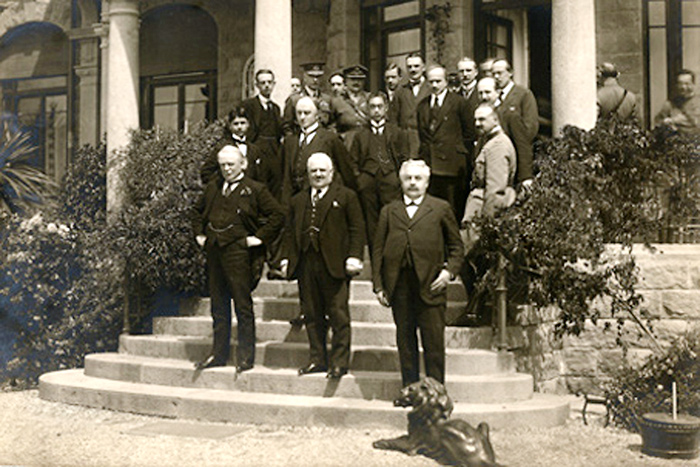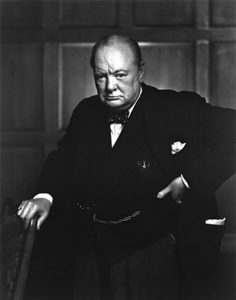
A century ago, many of the world’s great statesmen gathered in the Italian city of Genoa to build a monetary order for the post-war world.
Before 1914, the world’s leading economies had been on the classical gold standard. This was based on convertibility between paper money and gold at a fixed parity price and the free export and import of gold.
If a central bank set a parity price of £5 per ounce of gold, for example, an expansion of the money supply relative to gold reserves would push the market price up to, say, £6 per oz. In this case, it would make sense to take a £5 note to the bank, buy 1 ounce of gold, and sell it on the market for £6. During monetary contractions, the process worked in reverse. If the market price fell to, say, £4 per ounce it would make sense to buy an ounce of gold on the market for £4 and sell it to the bank for £5. In each case convertibility corrected monetary expansion or contraction. In an expansion, gold would flow out of banks forcing a contraction in the currency if they wished to maintain their reserve ratios. Likewise, a contraction would see gold flow into banks which would expand their issue of currency.
The First World War shattered this system. Countries financed their war efforts by printing money and convertibility and exportability were suspended. Between 1914 and 1918, total metallic reserves as a share of bank notes plus deposits fell from 63 to 1 percent in Austria-Hungary, 57 to 10 percent in Germany, 60 to 9 percent in Italy, 64 to 17 percent in France, and 40 to 33 percent in Britain. This caused rampant inflation, followed by a bust. In 1920, the League of Nations reported:
After the war most countries wished to return to the gold standard but faced a problem: there was now much more currency relative to their gold reserves. The parity prices of gold were far below the market prices, which would lead to massive outflows of gold once convertibility was re-established.
To solve this problem, among others, the statesmen gathered in April and May 1922. Their solution was the gold exchange standard.
The gold exchange standard would solve the imbalance between currency and gold reserves by increasing reserves. But the gold stock could not be expanded beyond new discoveries so the gold exchange standard allowed central banks to add to their gold reserves the assets of countries whose currency was convertible into gold. In practice these were sterling and dollars. By 1927, foreign exchange accounted for 42% of the total reserves (gold and foreign exchange) of twenty-four European central banks, up from 27% in 1924 and 12% in 1913.

But sterling assets were no longer deemed as ‘good as gold’. In 1925, Britain’s Chancellor of the Exchequer, Winston Churchill – against his better judgement – re-established sterling convertibility at the pre-war parity. This was too high and helped cripple British exports. Attempts to drive wages down in an internal devaluation provoked the General Strike in 1926. Countries like France and Germany began to switch their sterling for gold. From 1924 to 1928, foreign exchange fell from 59% of Germany’s total reserves to just 8%. Sterling couldn’t cope; liabilities stood at $2.5 billion, nearly four times the Bank of England’s gold reserves.
In 1927, Montagu Norman, Governor of the Bank of England, persuaded his friend Benjamin Strong, Governor of the Federal Reserve Bank of New York, to cut the Fed funds rate in the hope of relieving pressure on sterling. Whatever relief this action bought sterling, some economists have seen it as a cause of the stock market bubble that burst so spectacularly in 1929.
The Wall Street crash and its aftermath wrecked the gold exchange standard. As budget deficits grew, sterling came under renewed pressure in 1931. Unable to enact ‘austerity’ measures, the Labour government collapsed and was replaced by a National Government which promptly devalued (an external devaluation): “`Nobody told us we could do that”, one Labour politician observed. With a core country severing its link to gold others soon followed. By the end of 1932 32 countries had gone off gold. ‘Beggar-thy-neighbour’ devaluations would continue through the 1930s.
The gold standard is sometimes blamed for the Great Depression but the classical gold standard was history by then: as economist Richard Timberlake notes, “The operational gold standard ended forever at the time the United States became a belligerent in World War I”. The flaws in its successor, however, the gold exchange standard, designed a century ago, carry much more culpability.
John Phelan is an Economist at Center of the American Experiment.

READER COMMENTS
Thomas Lee Hutcheson
Jun 19 2022 at 10:16pm
Yes the Gold exchange standard did/would not allow central banks to find the optimal inflation target given the shocks that could be expected and the flexibility or relative nominal prices. Only by great good fortune would that correspond to the rate of increase of gold and foreign currency at any given time.
Question, instead of the “gold exchange” standard, why did each country not just re-adopt a gold standard but at an inflated price for gold that would not, as in the UK, force deflation? That would be less arbitrary than fixing the price of gold at a level that (possibly) with reserve currencies would not force deflation. Or just floating exchange rates as Freidman would later advocate.
Matthias
Jun 20 2022 at 9:21am
For the question in your second paragraph, you probably have to look to history. For example Britain got off the gold standard during Napoleon’s war, but later got back on it.
Presumably despite the great effor Britain benefitted from getting back on the gold standard at that time, and that what was made them repeat the attempt.
(Here’s some speculation: a country that very credibly on the gold standard will probably find it easier to borrow at low real interest rates. A country that credibly gets back on the gold standard time after time presumably enjoys some of these benefits, but also enjoys some benefits from being able to devalue the currency temporarily in times of war.)
Comments are closed.